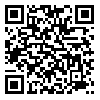Volume 59, Issue 6 (11-2001)
Tehran Univ Med J 2001, 59(6): 37-43 |
Back to browse issues page
Download citation:
BibTeX | RIS | EndNote | Medlars | ProCite | Reference Manager | RefWorks
Send citation to:



BibTeX | RIS | EndNote | Medlars | ProCite | Reference Manager | RefWorks
Send citation to:
Sadat M, Karami M. Hardware breakage in spine surgery (A retrospective clinical study) . Tehran Univ Med J 2001; 59 (6) :37-43
URL: http://tumj.tums.ac.ir/article-1-5623-en.html
URL: http://tumj.tums.ac.ir/article-1-5623-en.html
Abstract: (4373 Views)
This was a retrospective review of a consecutive series of patients with spinal disease in year 2000, who underwent posterior fusion and instrumentation with Harrington distraction and Cotrel-Dobousset system to evaluate causes of hardware failure. Many cases of clinical failure has been observed in spinal instrumentation used in spinal disorder like spondylolisthesis, fractures, deformities, … . Thirty six cases that were operated because of spinal disorders like spondylolisthesis, fractures, deformities, …, were included in this study. Seventeen of this cases had breakage of device. Factors like age at surgery, type of instrumentation, angles before and after surgery and …, were compared in two groups of patients. The most common instrument breakage was pedicle screw breakage. Pseudoarthrosis was the main factor that was presented in failure group (P value<0.001). Other important causes were, age of patient at surgery (P value=0.04), pedicle screw placement off center in the sagittal or coronal plane of the pedicle (P value=0.04). Instrumentation loads increased significantly as a direct result of variations in surgical technique that produce pseudoarthrosis, pedicle screw placement off center in the sagittal plane of the pedicle, or using less than 6 mm diameter screw. This factor can be prevented with meticulous surgical technique and using proper devices.
Type of Study: Original Article |
| Rights and permissions | |
 |
This work is licensed under a Creative Commons Attribution-NonCommercial 4.0 International License. |





